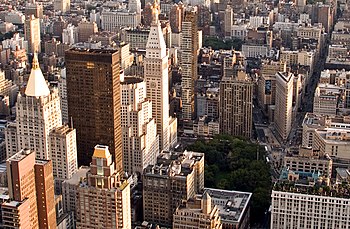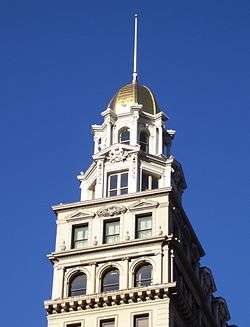Flatiron District
The Flatiron District is a neighborhood in the New York City borough of Manhattan, named after the Flatiron Building at 23rd Street, Broadway and Fifth Avenue. Generally, the Flatiron District is bounded by 14th Street, Union Square and Greenwich Village to the south; the Avenue of the Americas (Sixth Avenue) and Chelsea to the west; 23rd Street and Madison Square (or NoMad) to the north; and Park Avenue South and Gramercy Park to the east.[1][2][3][4][5][6]

Broadway cuts through the middle of the district, and Madison Avenue begins at 23rd Street and runs north. At the north (uptown) end of the district is Madison Square Park, which was completely renovated in 2001. The Flatiron District encompasses within its boundaries the Ladies' Mile Historic District and the birthplace of Theodore Roosevelt, a National Historic Site. The Flatiron District was also the birthplace of Silicon Alley, a metonym for New York's high technology sector, which has since spread beyond the area.[7][8]
The Flatiron District is part of Manhattan Community District 5.[9] Residents are represented by the Flatiron Alliance neighborhood association[10][11] and nearby businesses by the Flatiron/23rd Street Partnership business improvement district,[12][13] though the two have different (partially overlapping) boundaries.[4]
History and name
The designation "Flatiron District" dates from around 1985, and came about because of its increasingly residential character,[14][15] and the influx of many restaurants into the area[16] – real estate agents needed an appealing name to call the area in their ads. Before that, the area was primarily commercial, with numerous small clothing and toy manufacturers,[17] and was sometimes called the Toy District. The Toy Center buildings at 23rd Street and Broadway date from this period, and the annual American International Toy Fair took place there beginning in 1903, except for 1945. When much of this business moved outside the U.S., the area began to be referred to as the Photo District[17] because of the large number of photographers' studios and associated businesses located there, the photographers having come because of the relatively cheap rents.[18]
As of the 2000s, many publishers have their offices in the district, as well as advertising agencies,[19] and the number of computer- and Web-related start-up companies in the area caused it to be considered part of "Silicon Alley" or "Multimedia Gulch", along with TriBeCa and SoHo.[20]
Buildings


The Flatiron District is located in the part of Manhattan where the bedrock Manhattan schist is located deeper underground than it is above 29th Street and below Canal Street, and as a result, and under the influence of zoning laws, the tallest buildings in the area used to top out at around 20 stories; older buildings of 3-6 floors are still numerous, especially on the side streets.
Notable buildings in the district include the Flatiron Building, one of the oldest of the original New York skyscrapers, and just to east at 1 Madison Avenue is the Met Life Tower, built in 1909 and the tallest building in the world until 1913, when the Woolworth Building was completed. It is now occupied by Credit Suisse since MetLife moved their headquarters to the Pan Am Building. The 700-foot (210 m) marble clock tower of this building dominates Madison Square and the park there.
Nearby, on Madison Avenue between 26th and 27th Streets, on the site of the old Madison Square Garden, is the New York Life Building, built in 1928 and designed by Cass Gilbert, with a square tower topped by a striking gilded pyramid. Also of note is the statuary adorning the Appellate Division of the New York State Supreme Court on Madison Avenue at 25th Street.
Completed in 2010, One Madison Park, a 50-story luxury condominium tower, sits at 23 East 22nd Street, at the foot of Madison Avenue and across from Madison Square Park.[21] It is nearly as tall as the Met Life Tower (617.5 feet (188.2 m), compared to 700 feet (210 m) for the Tower), and taller than the Flatiron Building. The triplex penthouse was purchased for $57.3 million in February 2014.[22]
Another landmark is the 1909 sidewalk clock outside 200 Fifth Avenue.[23]
Education
The campus of the City University of New York's Baruch College is located between 23rd and 25th Streets on Lexington Avenue, at the eastern edge of the district.[24] The Field Building at 23rd Street and Lexington Avenue, the oldest building on the Baruch campus,[25] sits on the former site of the Free Academy (now City College of New York), which was founded in 1847 and was the first institution of free public higher education in the United States. Baruch's Newman Vertical Campus as well as the Zicklin School of Business, the largest collegiate school of business in the United States, are also located on 24th and 25th Streets between Third and Lexington Avenues.
Culture and shopping

Attractions in the area include the Museum of Sex and the Gershwin Hotel, both located on 27th Street. The Gershwin is a tribute to the late pop artist Andy Warhol, and features some of his art and memorabilia throughout the hotel.
The area has many stores, such as Ann Taylor, Victoria's Secret, Club Monaco, and Origins. "Big-box" retailers dominate Sixth Avenue between 14th Street and 23rd Street, at the district's western edge.
One of the neighborhood's older restaurants is Eisenberg's Sandwich Shop, founded in 1929 and saved in 2005 by a loyal customer.[26]
Notable residents
- Joe Quesada, comic book writer/artist/editor, and Chief Creative Officer of Marvel Comics.[27]
- Chelsea Clinton, the daughter of U.S. President Bill Clinton and Secretary of State Hillary Clinton, as well as her husband Marc Mezvinsky and their children, moved to the Flatiron District in 2016, having previously lived in nearby NoMad and Gramercy Park.[28][29]
See also
- Ladies' Mile Historic District
- Madison Square North Historic District
- Madison Square Park
References
Notes
- Jackson, Kenneth T., ed. (2010). The Encyclopedia of New York City (2nd ed.). New Haven: Yale University Press. p. 2179. ISBN 978-0-300-11465-2. "Flatiron district. Neighborhood in Manhattan, lying between Chelsea and Gramercy Park and bounded to the north by 23rd Street, to the east by Park Avenue, to the south by 14th Street, and to the west by Sixth Avenue."
- Jack Finnegan (2007). Newcomer's Handbook For Moving to and Living in New York City. p. 37.
- Aileen Jacobson (2017-02-22). "Living in the Flatiron District: Not Just a Place to Shop". New York Times.
- John Freeman Gill (2012-04-01). "Flatiron District/Living In: Profile, Always High, Keeps Current Too". New York Times.
The boundaries of the Flatiron can be a subject of disagreement, but the district generally runs from the Avenue of the Americas to Park Avenue South between 14th and 23rd Streets, excluding the blocks adjacent to Union Square. Still, as often happens when a neighborhood becomes popular, some see its borders as expanded. The Flatiron 23rd Street Partnership...places the northern boundary in the upper 20s, an area some call NoMad, or North of Madison Square Park.
- "Flatiron District". PropertyShark. Retrieved 2018-01-12. New York City real estate map, showing the Flatiron District bounded by 14th Street, 23rd Street, Sixth Avenue, and Park Avenue South.
- Neighborhoods in New York City do not have official status, and their boundaries are not specifically set by the city. (There are a number of Community Boards, whose boundaries are officially set, but these are fairly large and generally contain a number of neighborhoods and the neighborhood map Archived September 15, 2012, at the Wayback Machine issued by the Department of City Planning only shows the largest ones.) Because of this, the definition of where neighborhoods begin and end is subject to a variety of forces, including the efforts of real estate concerns to promote certain areas, the use of neighborhood names in media news reports, and the everyday usage of people.
- Karim Lahlou. "Startups move to co-shared offices amid high real estate prices". The Midtown Gazette. Retrieved August 20, 2014.
- Fergal Gallagher (2015-11-04). "The mysterious origins of the term Silicon Alley revealed". Built in NYC.
- "NYC Planning | Community Profiles". communityprofiles.planning.nyc.gov. New York City Department of City Planning. Retrieved June 6, 2018.
- Block Associations
- Flatiron Alliance
- "Flatiron District Map" on the Flatiron/23rd Street Partnership website
- Flatiron: Where Then Meets Now / Flatiron District: The Synergies of Real Estate & Coworking Culture, Fall 2015
- "If You're Thinking of Living in: The Flatiron District". The New York Times. December 22, 1991. Retrieved 2009-08-22.
- Bill Cresenzo (2009-01-21). "Midtown proves its mettle". Brokers Weekly (via Corcoran).
- Kennedy, Shawn G. (June 3, 1987). "In Flatiron Area, Cafe Expansion". The New York Times. Retrieved 2009-08-22.
- Alexiou, Alice Sparberg (2010), The Flatiron: The New York Landmark and the Incomparable City that Arose With It, New York: Thomas Dunne/St. Martin's, ISBN 978-0-312-38468-5, p.268
- Hawkins, David S. (October 30, 1988). "If You're Thinking of Living in:; Flatiron District". The New York Times. Retrieved 2009-08-22.
- Blau, Eleanor (July 25, 1985). "Mix of People and Business". The New York Times. Retrieved 2009-08-22.
- Pulley, Brett (February 13, 1995). "New York Striving to Become Technology's Creative Center". The New York Times. Retrieved 2009-08-22.
- Rubinstein, Dana (April 16, 2010). "One Madison Park to Receivership; Flood of Sales to Come?". The New York Observer. Retrieved May 15, 2010.
- Finn, Robin (July 11, 2014). "Big Ticket | Rupert Murdoch's Trophy Pad, Expanded". The New York Times. Retrieved March 12, 2015.
- White, Norval & Willensky, Elliot (2000). AIA Guide to New York City (4th ed.). New York: Three Rivers Press. ISBN 978-0-8129-3107-5.
- "Map and Directions - Baruch College". cuny.edu. Baruch College. Retrieved August 2, 2017.
- Holland, Heather (April 24, 2014). "Baruch College's Oldest Building Gets $90M Upgrade". DNAinfo New York. Archived from the original on August 2, 2017. Retrieved August 2, 2017.
- Koppel, Lily (2006-03-23). Sandwich Shop Stays, Saved by a Regular. New York Times. 23 March 2006. Retrieved from https://www.nytimes.com/2006/03/23/nyregion/sandwich-shop-stays-saved-by-a-regular.html.
- Mala, Elisa (September 30, 2011). "Espresso and the Incredible Hulk". The New York Times.
- Heller, Jill (March 15, 2013). "Chelsea Clinton Apartment: Former First Daughter Scoops Up $10.5 Million Madison Square Park Pad". International Business Times. Retrieved March 16, 2013.
- Walker, Ameena (2016-07-29). "Chelsea Clinton's former Madison Square Park pad already in contract". Curbed NY. Retrieved 2016-07-30.
External links
| Wikimedia Commons has media related to Flatiron District, Manhattan. |
| Wikivoyage has a travel guide for Gramercy-Flatiron. |
- Flatiron/23rd Partnership BID
- Madison Square Park Conservancy
- History of the International Toy Center
- Drive to Protect the Ladies' Mile
- Madison Square Park News